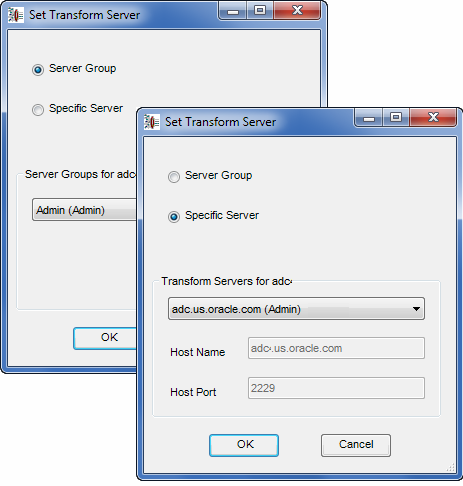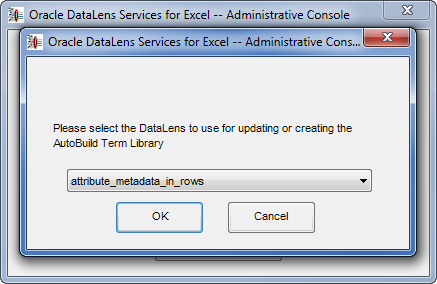| Oracle® Enterprise Data Quality for Product Data Services for Excel Reference Guide Release 11g R1 (11.1.1.6) Part Number E29143-03 |
|
|
PDF · Mobi · ePub |
| Oracle® Enterprise Data Quality for Product Data Services for Excel Reference Guide Release 11g R1 (11.1.1.6) Part Number E29143-03 |
|
|
PDF · Mobi · ePub |
This chapter describes how to prepare for and install EDQP Services for Excel, log into the Oracle DataLens Server or change this server, and how to configure the application options.
This section provides detailed software and hardware prerequisites, and how to obtain the Services for Excel software in preparation for installing.
You must ensure that the following Oracle DataLens Server hardware and software requirements are observed. These requirements represent the certified and supported server configurations.
Verify that you have met the minimum server requirements using the Oracle Enterprise Data Quality for Product Data Hardware and Software Specification found at the Oracle Enterprise Data Quality for Product Data Documentation Web site:
The following Enterprise DQ for Product prerequisites must be installed before using Services for Excel.
Oracle DataLens Server-provides access to DSAs to execute a job immediately and run it synchronously. For more information, see Oracle Enterprise Data Quality for Product Data Oracle DataLens Server Installation Guide.
Application Studio, which is used to create and maintain DSAs. Governance Studio, which is used by to manage and process data using the Oracle DataLens Server. Knowledge Studio, which is used to create and maintain data lenses. These client applications are installed as part of the Oracle DataLens Server installation and can be accessed from the EDQP Welcome Launch Pad. For more information, see Oracle Enterprise Data Quality for Product Data Getting Started Guide.
A Windows Administrator user account must be used to install or uninstall Services for Excel so that the necessary dynamic-link libraries (DLLs) are properly registered or unregistered.
Contact your system administrator for assistance in creating a new or identifying an existing Windows Administrator user account.
The Services for Excel installer is a standard Windows Installer executable file and installs on both 32-bit and 64-bit Window operating system client machines running Microsoft Excel 2003, 2007, or 2010. Any previous versions of the software is automatically uninstalled as part of the installation. The Services for Excel installer file is obtained from the Oracle DataLens Server Welcome Web page.
Use the following steps to install the product on any supported client machine:
Ensure that Excel is closed.
Start your Oracle DataLens Server to use the Welcome Launch Pad. For details, see Oracle Enterprise Data Quality for Product Data Getting Started.
Click the AutoBuild button to download the appropriate Services for Excel installation file for your version of Excel.
Depending on the Download and Security settings in your browser, you may be asked to save the installer file, run it, or it automatically downloads.
If prompted by a Security Warning dialog, click Run to run the file and continue the installation.
Otherwise, locate the downloaded DataLensServicesForExcelSetup.exe file and double-click it to start the installation.
The installer begins, identifies the Excel version, installs accordingly, completes the installation, and starts Excel.
Note:
If a Warning is displayed prompting you to overwrite an existingDLS_Import_Template.project-date file, click Yes to update the file.Ensure that the Services for Excel Add-In toolbar is present.
The Services for Excel toolbar is identical in all supported versions of though they are presented differently. When using Excel 2007 or 2010, you must click the Add-Ins tab to access the toolbar. The appearance of the toolbar indicates a successful installation of the Services for Excel product.
The following sections describe known issues and any workarounds that may occur when installing or using Services for Excel.
Excel files do not open when you double-click an Excel workbook or short-cut to an Excel file
When opening Excel and an Excel file by double-clicking on it, Excel starts but the file is not opened. This is a known issue with the Excel application and can be corrected by following the instructions at the Microsoft Support Web site at
http://support.microsoft.com/kb/211494
Services for Excel Add-in does not appear in Excel 2003 on a 32-bit Windows 7 system after a successful Installation
This is a result of a problem with the 32-bit Microsoft Office 2003 Primary Interop Assemblies (PIA) including the necessary .Net Programmability Support not being installed and is a known issue. You can correct this issue by downloading and installing following the Microsoft Office 2003 PIA using the instructions at the Microsoft Download Web site at
http://www.microsoft.com/en-us/download/details.aspx?id=20923
You can log in or change the user that is currently logged into the Oracle DataLens Server and change the server to use to transform your data.
Note:
You must log in to the server for all job processing activities. The login applies to all spreadsheets within the workbook. If you want to use a different login then use the Switch User option on the DataLens Tools menu. You can also open an entirely new workbook to log in as a different user.To change the user or Oracle DataLens Server, click DataLens Tools and select Switch User....

The Oracle Enterprise Data Quality for Product Data Login dialog box appears.
Enter a valid user name and password and click OK. You can avoid entering this password every time you logon as this user by selecting the Remember Password check box.
Changing the Oracle DataLens Administration Server
Click the Change Server button. Enter the name or IP Address of the Oracle DataLens Administration Server that you want to use to transform your data. If the server does not run on the default port number 2229, enter the correct port number. Click OK to change servers.
You can specify a server group or a specific server to use to transform your data.
To change the user or Oracle DataLens Server, click DataLens Tools and select Set Transform Server... .

Set the Oracle DataLens Transform Server by selecting one of the following:
Select the server group from the Oracle DataLens Server Group list, and then click OK to change the server group.
Select a server from the Oracle DataLens Server Group list. If the server runs does not run on the default port number 2229, enter the correct port number. Click OK to change servers.
You can configure a Term Library to augment and enhance your data lens grammar. A Term Library is composed of the term variants found in an existing data lenses. You can either create a new Term Library or add to an existing Term Library .
On the Services for Excel toolbar, click DataLens Tools, and then select Options.

Select <Create New> to create a new Term Library or select a Term Library from the list to update an existing library.
The Term Library you create or update is used by AutoBuild by extracting terms from the data lens that you select. This is particularly useful when you have extensive term variant refinements (in fact, term variant refinement are the only type of refinement used in Term Libraries) in a data lens that you want to leverage in new data lens.
Click Update Term Library, and then select the data lens that you want to use to create an initial one or update the existing Term Library.
Click OK.

The Term Library is created or updated to include these new terms and variations. The extracted terms are case insensitive, all underscores, plurals, and duplicates (containing identical variants) are removed.
After creating a new Term Library it is automatically stored in the correct location required by AutoBuild, and then you can update the Term Library one data lens at a time. In Step 1 of the AutoBuild wizard, you can make your Term Library selection by clicking the Category Details button.
Upon completion, a report is displayed that details all of the terms that were updated for you to review and save.
Note:
If the data lens names do not display properly (as is sometimes the case with full-width characters), ensure that your Windows region and language options are set properly. For more information, see Windows Help.